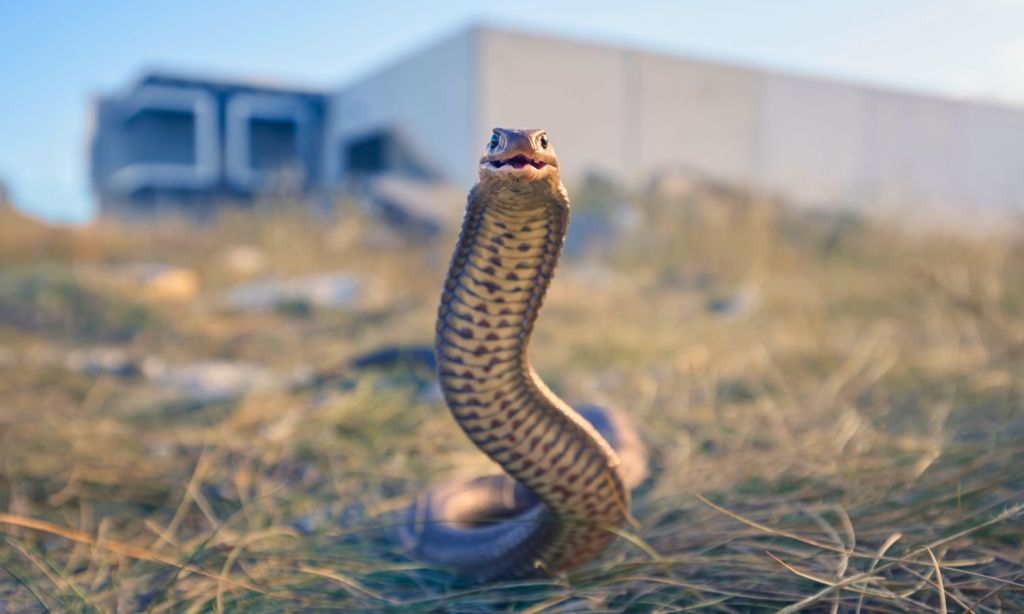Snake catchers are advising people to be on the lookout for snakes in Australia as temperatures climb and the reptiles become more active.
Tristan Hamilton, a snake catcher working on the border between Victoria and New South Wales has detailed the need for his services three times in a single day in the Albury-Wodonga region.
“A woman called to say she saw the snake fall from their retaining wall and onto pavers while her daughter was swimming in the nearby pool,” Mr Hamilton said.
“She was quick to call and even grabbed a video of the snake.”
The warning comes after reports earlier in the year that snake season in Australia will start earlier and last longer thanks to the changing climate.
Warmer temperatures mean snakes move around more frequently in the search for food, water, and breeding mates. And there has been a surge in callouts and an increase in snake bites this year thanks to the warmer weather.
Illawarra snake catcher Glen Peacock told the Sydney Morning Herald in September that he had caught and released 50% more snakes at the start of the season compared to last year.
“Normally it’s not until the first couple of weeks of spring that I get calls, but I was getting calls for the whole last month of winter,” he said.
“I’ve seen a number of dogs bitten in the last few weeks as well.”
Hamilton noted that brown snakes, red-bellies, and tiger snakes are the three most common snakes he deals with on callouts and warns people to be careful around long grass on warmer days.
When Is Snake Season?
Snakes in Australia normally come out of brumation – a type of hibernation for cold-blooded animals – in mid-September as the weather warms up. They hide away and enter this state as the temperatures drop around April.
Not all Australian snakes enter brumation as the temperature doesn’t get cold enough across the continent. In southern regions, snakes will enter this state to conserve energy but snakes in tropical regions are active all year round.
Brumation is however different to hibernation. Snake hunter Mark Pelley, who works around the northern Melbourne region, has said that brumation means the animals are “semi-dormant.” They still move around in search of water and will change location if they’re disturbed.
“In extremely cold weather, the latency period is extended and snakes remain dormant for longer,” he has said.
“Regardless of the temperature, snakes can still be around and can bite any person who is unfortunate enough to come across one”.
What Should You Do If You Find a Snake?
There are 140 species of snake on the Australian mainland and 100 of those are venomous. However, only 12 of them are actually capable of killing a person.
Depending on where you come across a snake, the recommended action is slightly different but, generally, staying calm and then slowly moving in the opposite direction is advised.
Walkers are advised to always be on the lookout for snakes in Australia on a hike and to move away from them if seen.
If you find a snake in your home, don’t attempt to catch or kill it. Calling in snake catchers, who are legally required to release them away from homes, is the best option.
“Don’t corner it, just keep an eye on the snake from a safe distance until a snake handler arrives,” Hamilton said.
“It’s much quicker and easier for us if you know where it is because if you take your eyes off them they will make an escape and go into hiding.”
You can reduce the chances of a snake coming into your house by keeping lawns cut short, removing debris or rubbish that they might hide in, and disposing of food scraps properly.
Snakes are protected by law in all states and territories in Australia and it is illegal to kill them unless they are a threat to life. They cannot be removed from the wild without a licence either and there are penalties for doing so.
Related: Yikesss! Snake Season Is Huge, Thanks to the La Niña
Related: Scientists Discover a New Snake Species and Name it After a Harry Potter Character
Read more stories from The Latch and subscribe to our email newsletter.







